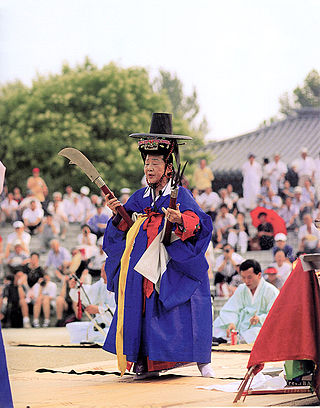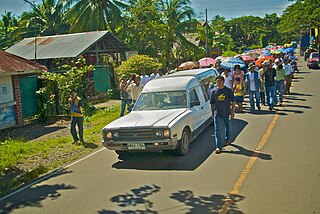Related Research Articles

A funeral is a ceremony connected with the final disposition of a corpse, such as a burial or cremation, with the attendant observances. Funerary customs comprise the complex of beliefs and practices used by a culture to remember and respect the dead, from interment, to various monuments, prayers, and rituals undertaken in their honour. Customs vary between cultures and religious groups. Funerals have both normative and legal components. Common secular motivations for funerals include mourning the deceased, celebrating their life, and offering support and sympathy to the bereaved; additionally, funerals may have religious aspects that are intended to help the soul of the deceased reach the afterlife, resurrection or reincarnation.

The veneration of the dead, including one's ancestors, is based on love and respect for the deceased. In some cultures, it is related to beliefs that the dead have a continued existence, and may possess the ability to influence the fortune of the living. Some groups venerate their direct, familial ancestors. Certain religious groups, in particular the Eastern Orthodox Churches, Catholic Church and Anglican Church venerate saints as intercessors with God; the latter also believes in prayer for departed souls in Purgatory. Other religious groups, however, consider veneration of the dead to be idolatry and a sin.

Burial, also known as interment or inhumation, is a method of final disposition whereby a dead body is placed into the ground, sometimes with objects. This is usually accomplished by excavating a pit or trench, placing the deceased and objects in it, and covering it over. A funeral is a ceremony that accompanies the final disposition. Evidence suggests that some archaic and early modern humans buried their dead. Burial is often seen as indicating respect for the dead. It has been used to prevent the odor of decay, to give family members closure and prevent them from witnessing the decomposition of their loved ones, and in many cultures it has been seen as a necessary step for the deceased to enter the afterlife or to give back to the cycle of life.

The traditional culture of Korea is the shared cultural and historical heritage of Korea before the division of Korea in 1945.

Korean shamanism, also known as Mu-ism and musok, is a religion from Korea. Scholars of religion have classified it as a folk religion. There is no central authority in control of musok, with much diversity of belief and practice evident among practitioners.

The majority of funerals in Japan include a wake, the cremation of the deceased, a burial in a family grave, and a periodic memorial service. According to 2007 statistics, 99.81% of deceased Japanese are cremated.

Stories and practices that are considered part of Korean folklore go back several thousand years. These tales derive from a variety of origins, including Shamanism, Confucianism, Buddhism, and more recently Christianity.

Asian witchcraft encompasses various types of witchcraft practices across Asia. In ancient times, magic played a significant role in societies such as ancient Egypt and Babylonia, as evidenced by historical records. In the Middle East, references to magic can be found in the Torah and the Quran, where witchcraft is condemned due to its association with belief in magic, as it is within other Abrahamic religions.

Roman funerary practices include the Ancient Romans' religious rituals concerning funerals, cremations, and burials. They were part of time-hallowed tradition, the unwritten code from which Romans derived their social norms. Elite funeral rites, especially processions and public eulogies, gave the family opportunity to publicly celebrate the life and deeds of the deceased, their ancestors, and the family's standing in the community. Sometimes the political elite gave costly public feasts, games and popular entertainments after family funerals, to honour the departed and to maintain their own public profile and reputation for generosity. The Roman gladiator games began as funeral gifts for the deceased in high status families.

A Christian burial is the burial of a deceased person with specifically Christian rites; typically, in consecrated ground. Until recent times Christians generally objected to cremation because it interfered with the concept of the resurrection of a corpse, and practiced inhumation almost exclusively. Today this opposition has all but vanished among Protestants and Catholics alike, and this is rapidly becoming more common, although Eastern Orthodox Churches still mostly forbid cremation.

Chinese ancestor veneration, also called Chinese ancestor worship, is an aspect of the Chinese traditional religion which revolves around the ritual celebration of the deified ancestors and tutelary deities of people with the same surname organised into lineage societies in ancestral shrines. Ancestors, their ghosts, or spirits, and gods are considered part of "this world". They are neither supernatural nor transcendent in the sense of being beyond nature. The ancestors are humans who have become godly beings, beings who keep their individual identities. For this reason, Chinese religion is founded on veneration of ancestors. Ancestors are believed to be a means of connection to the supreme power of Tian as they are considered embodiments or reproducers of the creative order of Heaven. It is a major aspect of Han Chinese religion, but the custom has also spread to ethnic minority groups.
Gurung Shamanism is arguably one of the oldest religions in Nepal. It describes the traditional shamanistic religion of the Gurung people of Nepal. There are three priests within the Gurungs which are Pachyu, Khlepree and Bonpo Lama. Tamus do not have a written script; nowadays they use the Devanagari script. However, the Tamus have created their own script called 'Khema Script' which is taught in Rupandehi, Nepal, and is widely taught even in overseas countries like Sikkim, India. The pronunciation of the word 'Pachyu' and 'Khlepree' are often different from one village to another. Pachyu are sometimes referred to as 'Poju or Pajyu' and Khlepree is also known as 'Lhori or Ghyabri'. Bonpo Lamais the proper term for a Gurung Lama. The "Pachyu" is understood to be the first priest amongst the three priests followed by Khlepree and lastly the Bonpo Lam. Pachyu, Khlepree and Bonpo Lams' recite chants of ancient legends and myths. These sacred myths and legends within the Pe are historical events and stories which dates back to as early as the creation of Earth to stories that have occurred within the Gurung societies as they are one of the indigenous people of Nepal.

Gut are the rites performed by Korean shamans, involving offerings and sacrifices to gods, spirits and ancestors. They are characterised by rhythmic movements, songs, oracles and prayers. These rites are meant to create welfare, promoting commitment between the spirits and humankind. The major categories of rites are the naerim-gut, the dodang-gut and the ssitgim-gut.

During the Pre-Hispanic period the early Filipinos believed in a concept of life after death. This belief, which stemmed from indigenous ancestral veneration and was strengthened by strong family and community relations within tribes, prompted the Filipinos to create burial customs to honor the dead through prayers and rituals. Due to different cultures from various regions of the Philippines, many different burial practices have emerged. For example, the Manobos buried their dead in trees, the Ifugaos seated the corpse on a chari before it was brought to a cave and buried elsewhere. The most common forms of traditional burials are supine pits, earthenware jars, and log coffins, and have been a topic of interest among Philippine archaeologists since the early 20th century.

Ancient Greek funerary practices are attested widely in literature, the archaeological record, and in ancient Greek art. Finds associated with burials are an important source for ancient Greek culture, though Greek funerals are not as well documented as those of the ancient Romans.

Mu (Korean: 무) is the Korean term for a shaman in Korean shamanism. Korean shamans hold rituals called gut for the welfare of the individuals and the society.

Chinese funeral rituals comprise a set of traditions broadly associated with Chinese folk religion, with different rites depending on the age of the deceased, the cause of death, and the deceased's marital and social statuses. Different rituals are carried out in different parts of China, and many contemporary Chinese people carry out funerals according to various religious faiths such as Buddhism or Christianity. However, in general, the funeral ceremony itself is carried out over seven days, and mourners wear funerary dress according to their relationship to the deceased. Traditionally, white clothing is symbolic of the dead, while red is not usually worn, as it is traditionally the symbolic colour of happiness worn at Chinese weddings. The number three is significant, with many customary gestures being carried out three times.
The Four Ceremonial Occasions. The four rites of passage celebrated in this tradition are the coming of age, marriage, death, or the funeral rites, and rites venerating the ancestors. The word Gwanhonsangje an acronym, made of the first letter of each word.
Josang refers to one's immediate ancestors, offspring, a deceased relative or any unrelated soul; and worshipped as a god in Korean Shamanism. It is viewed as a supernatural being rather than blood relations, includes all immediate and extended family, both male and female, and all other deceased souls that influence the family. These include who died before marriage, or who died a tragic, untimely death.
References
- ↑ Pettid, Michael J. (2014). Death, Mourning, and the Afterlife in Korea from Ancient to Modern Times. University of Hawaii Press. p. 137.
- ↑ Schwartz, Enid. "Death Practices from a Korean Perspective". Indiana. Grief in a Family Context.
- ↑ Lee, Kwang Kyu (2003). Rites of passage. Jimoondang. pp. 195–199.
{{cite book}}: CS1 maint: location missing publisher (link) - ↑ Yoon, Hong-key (1975). "An Analysis of Korean Geomancy Tales". Asian Folklore Studies. 34 (1): 21–34. doi:10.2307/1177738. JSTOR 1177738.
- ↑ Pettid, Michael J. (2014). Death, Mourning, and the Afterlife, form Ancient to Contemporary Times. University of Hawaii Press. p. 137.
- ↑ Kalland, A (1996). "Geomancy and Town Planning in Japanese Community". Ethnology. 35 (1): 17–32. doi:10.2307/3774022. JSTOR 3774022.
- ↑ Dredge, Paul. "What's in a Funeral? Korean, American-Mormon and Jewish Rites Compared". Religious Studies Centre, Brigham Young university.
- ↑ Lee, Kwang Kyu (2003). Rites of passage. Jimoondang. pp. 195–199.
{{cite book}}: CS1 maint: location missing publisher (link) - ↑ Park, Mee Hae (June 2014). "An Evolving Confucian Patriarchy: An Analysis of Wedding&Funeral Rites In Sixteenth-Century Korea". Acta Koreana . 17 (1): 299.
- ↑ "'믿거나 말거나' 생활 속 미신 15개". WIKITREE. 2016-06-16. Retrieved 2015-07-06.
- ↑ Biontino, Juljan (2020). "Changes in funerary rites and burial practices in Modern Korea (1876–1945)". Contemporary Japan. 32 (1): 12, 21. doi:10.1080/18692729.2020.1717131. S2CID 212940383.
- ↑ Han, Ri-Hye (2020). "Graveyard geomancy in Korea under Japanese rule – Focusing on the 1930s". Contemporary Japan. 32 (1): 25–42. doi:10.1080/18692729.2020.1716143. S2CID 212789409.
- ↑ "Funeral Rites". Korean Society Celebrations. Asianinfo.
- ↑ Dredge, Paul. "What's in a Funeral? Korean, American-Mormon and Jewish Rites Compared". Religious Studies Centre, Brigham Young university.
- ↑ Lee, Kwang Kyu (2003). Rites of passage. Jimoondang. pp. 195–199.
{{cite book}}: CS1 maint: location missing publisher (link) - ↑ Shoe, Keysook (2013). "A Weeping Man and the Mourning Ritual: Literati Writing and the Rhetoric of Funeral Oration in Eighteenth-Century Joseon". Korea Journal . 53 (1): 143–171.
- ↑ Shoe, Keysook (2013). "A Weeping Man and the Mourning Ritual: Literati Writing and the Rhetoric of Funeral Oration in Eighteenth-Century Joseon". Korea Journal . 53 (1): 143–171.
- ↑ Hogarth, Hyun-kye Kim (1994). "Korean Shamanism and Cultural Nationalism". TRANSACTIONS of the Royal Asiatic Society, Korea Branch. 69: 22.
- ↑ Hogarth, Hyun-kye Kim (1994). "Korean Shamanism and Cultural Nationalism". TRANSACTIONS of the Royal Asiatic Society, Korea Branch. 69: 1.
- ↑ Ladner, Mimsie. "On Death, Dying, and Funerals in Korea". Seoul Searching.
- ↑ Dredge, Paul. "What's in a Funeral? Korean, American-Mormon and Jewish Rites Compared". Religious Studies Centre, Brigham Young university.
- ↑ Park, Chang-Won (5 Mar 2010). "Funerary transformations in contemporary South Korea". Mortality. 15 (1): 18–37.